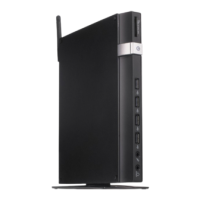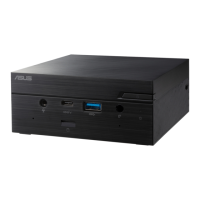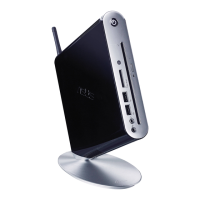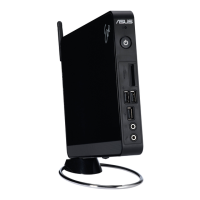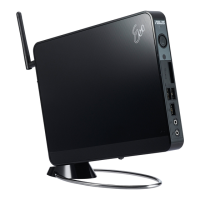Do you have a question about the Asus EeeBox PC EB1035 and is the answer not in the manual?
Details the front and rear views of the PC, identifying ports and features.
Identifies front panel ports, power button, and memory card slot.
Identifies rear panel ports, including antenna, HDMI, USB, LAN, and power input.
Instructions for setting up the PC on its stand and mounting it to a monitor using a VESA mount.
Steps to attach the PC to its included stand for stable placement.
Guide for attaching the PC to a monitor using a VESA mount kit.
Connect external displays, USB devices, Wi-Fi antenna, power on the PC, and configure HDMI audio output.
Connect PC to an external monitor or TV using HDMI or VGA cables.
Connect keyboards, mice, and other peripherals via USB ports.
Attach the wireless antenna for improved Wi-Fi signal reception.
Steps for turning the ASUS EB1035 PC on and off, including power management notes.
Set up the PC to output audio through an HDMI-connected device like a TV.
Specifies the minimum hardware requirements for running Windows 8 on the PC.
Guides through first-time startup, lock screen, user interface, and the Start screen.
Walkthrough for initial PC setup, license acceptance, and basic configuration.
Explains the tile-based interface, Start screen, and live tiles in Windows 8.
Manage Windows apps, use hotspots, launch/customize apps, use Charm bar, Snap feature, and keyboard shortcuts.
Launching, customizing, and closing apps; accessing the Apps screen.
Explains Charm bar functions and how to use the Snap feature for multitasking.
Lists useful keyboard shortcuts for navigating Windows 8 and launching applications.
Instructions for shutting down, sleeping the PC, and accessing/configuring BIOS settings.
Procedures for turning the PC off completely or putting it into sleep mode.
Guides on entering the BIOS and changing its settings safely.
How to connect to networks using Wi-Fi or a wired Ethernet connection in Windows 7.
Steps to connect to available Wi-Fi networks in Windows 7.
Instructions for establishing a wired network connection using an Ethernet cable.
How to connect to networks using Wi-Fi or a wired Ethernet connection in Windows 8.
Connect to Wi-Fi networks via the Charm bar and Settings in Windows 8.
Setting up wired network connections (dynamic/static IP, PPPoE) in Windows 8.
How to restore Windows 7 to factory settings using the recovery partition or create a backup.
Restores the PC to its original factory state using the built-in recovery partition.
Creates a backup of the factory default environment onto a USB drive for future recovery.
Options for resetting the PC, creating a recovery drive, and reinstalling Windows 8.
Restores the PC to factory default settings, with options to keep or remove files.
Creates a USB recovery drive to restore the PC from a system image.
Guides on removing everything and reinstalling Windows to factory settings.
Information on REACH, FCC statements, RF exposure, and conformity declarations.
Details on REACH, FCC, and Canadian radio interference regulations.
Information on RF exposure limits and the R&TTE directive declaration of conformity.
Specific wireless regulations and compliance for CE marking and ENERGY STAR.
Specific wireless frequency band restrictions for France and other regions.
Compliance for CE marking, safety, and ENERGY STAR certification.
| Bus type | DMI |
|---|---|
| Tjunction | 100 °C |
| Processor cache | 2 MB |
| Processor cores | 2 |
| System bus rate | - GT/s |
| Processor family | Intel® Celeron® |
| Processor series | Intel Celeron Processor 800 Series for Mobile |
| Processor socket | BGA 1023 |
| Processor codename | Sandy Bridge |
| Processor frequency | 1.1 GHz |
| Processor cache type | L3 |
| Processor lithography | 32 nm |
| Processor manufacturer | Intel |
| Processor front side bus | - MHz |
| PCI Express slots version | 2.0 |
| Processor operating modes | 64-bit |
| ECC supported by processor | No |
| PCI Express configurations | 1x8, 1x16, 2x4, 2x8 |
| Thermal Design Power (TDP) | 17 W |
| Number of processors installed | 1 |
| CPU multiplier (bus/core ratio) | 11 |
| Maximum number of PCI Express lanes | 16 |
| Memory types supported by processor | DDR3-SDRAM |
| Memory clock speeds supported by processor | 1066, 1333 MHz |
| Memory bandwidth supported by processor (max) | 21.3 GB/s |
| Maximum internal memory supported by processor | 16 GB |
| Memory slots | 1x SO-DIMM |
| Internal memory | 4 GB |
| Memory channels | Dual-channel |
| Memory clock speed | 1333 MHz |
| Memory layout (slots x size) | - GB |
| HDD speed | 5400 RPM |
| HDD interface | SATA II |
| Storage media | HDD |
| Optical drive type | - |
| Card reader integrated | Yes |
| Total storage capacity | 500 GB |
| Compatible memory cards | MMC, SD, SDHC, SDXC |
| Discrete graphics card model | Not available |
| On-board graphics card model | Intel® HD Graphics |
| On-board graphics card base frequency | 350 MHz |
| On-board graphics card dynamic frequency (max) | 800 MHz |
| Operating system installed | Windows 7 Professional |
| Wi-Fi standards | 802.11b, 802.11g, Wi-Fi 4 (802.11n) |
| Cabling technology | 10/100/1000Base-T(X) |
| Top Wi-Fi standard | Wi-Fi 4 (802.11n) |
| Ethernet LAN data rates | 10, 100, 1000 Mbit/s |
| PS/2 ports quantity | 0 |
| USB 2.0 ports quantity | 4 |
| Product color | Black |
| Product type | PC |
| Motherboard chipset | Intel® HM70 Express |
| Processor ARK ID | 56056 |
| Processor package size | 31.0 x 24.0 (BGA1023) mm |
| Supported instruction sets | SSE4.x |
| Power supply | 65 W |
| Depth | 219 mm |
|---|---|
| Width | 29 mm |
| Height | 172.5 mm |
| Weight | 690 g |
